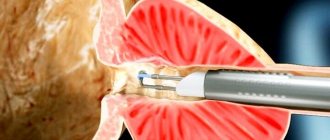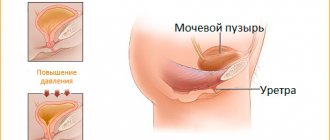The urethra is usually understood as the final part of the pathways responsible for the removal of urine from the body. Also, in addition to the main functionality, it acts as a channel for subsequent ejaculation of sperm. Currently, a fairly popular solution to the problem is buccal urethroplasty, which can be prescribed directly for strictures, or for abnormal development of the canal.
Important! The choice of the name and method of performing plastic surgery in the specified area completely depends directly on the nature of the manifested pathology, as well as its localization, as well as the level of immediate qualifications of the surgeon performing the work.
Features in men and women
The urethra is an elastic tube between the bladder and the external opening of the urethra. Urine is excreted through it. In women it is parallel to the vagina, and in men it goes through the penis and performs the function of releasing sperm.
In the stronger sex, problems with the urethra arise more often due to its more complex structure and two bends. In women, it is wider and shorter, so strictures are detected less often in them, although they are more susceptible to infectious diseases. So the need for plastic surgery of the external urethral opening in women often arises with regular exacerbations of cystitis.
Indications for plastic surgery
Typically, men undergo surgery for urinary stenosis caused by strictures. These are areas where the urethra partially narrows. Urine is still excreted, but lack of treatment threatens an excessive increase in pressure on the canal walls and subsequent rupture. Despite the fact that strictures rarely occur in women, if they block the urethra by more than a third, they are also prescribed plastic surgery.
A direct indication for surgery of the urinary canal is the presence of strictures more than 2 cm in length, especially in places of bends in men. These problems provoke injuries, tissue scarring, and infections.
Other indications:
- obliteration, that is, acute closure of the canal, in which urine is no longer excreted;
- congenital malformations of the urethra, including displacement of its opening (hypospadias) and splitting of its walls (epispadias);
- injuries and other damage to the urinary canal, pelvis;
- incontinence caused by deterioration of the functionality of the urethra.
For men, such interventions are also recommended during phalloplasty, in which the penis is reconstructed.
Holtsov's operation
Urethral strictures are narrowings of the lumen of the urethra.
As a result of the narrowing, difficulty urinating occurs, which, in the future, can cause a number of serious problems: chronic prostatitis, reproductive dysfunction, the appearance of residual urine in the bladder, impaired outflow of urine from the kidneys, renal failure, chronic pyelonephritis, etc. The main ones Difficulty urinating is a manifestation of urethral stricture. In addition to this, there may be other...
Strictures of the anterior urethra. Treatment. Reconstructive techniques
Urethroplasty is considered the ideal treatment for anterior urethral strictures. Can be performed on men of various age groups.
The following types of urethroplasty are distinguished: End-to-end anastomosis; Augmentation anastomotic urethroplasty; Replacement urethroplasty. End-to-end anastomosis is the method of choice in the treatment of short (less than 2 cm) strictures of the bulbous urethra.
The essence of this operation is the excision of a narrowed section of the urethra, spatulation of the ends of the urethra...
Treatment of urethral stricture with folk remedies
Treatment of urethral stricture can include a variety of techniques, from conservative to surgical, which, in turn, includes various surgical treatments from bougienage to plastic reconstructive surgery.
The choice of treatment method is always based on an individual approach to the patient, which takes into account the patient’s age, gender, wishes, size and location of the stricture, severity of the scarring process, the cause of the stricture, and anamnestic data.
Therefore, when...
Urethral stricture in women
Urethral stricture can affect both men and women. But in the latter, this disease is extremely rare, which is due to the peculiarities of anatomy and physiology.
The urethra in women is much shorter than in men, its length is about 3-5 cm. It is also straight, and its diameter is 1-1.5 cm. All this creates safer conditions and a lower risk of injury.
At the same time, women have a risk that men do not have - namely the risk of trauma during childbirth. Also...
Symptoms of urethral stricture
Urethral stricture is a narrowing of the urethra (urethra), which is formed due to some effect on the urethra (inflammation, ischemia, trauma), and sometimes without an obvious reason.
Symptoms of urethral stricture are changes in urination of varying degrees. You need to know that these can be a variety of manifestations, and also that they can be signs of other diseases.
The various symptoms of urethral stricture strongly correlate with the part of the organ in which it is located...
After surgery for urethral stricture
There are a huge number of operations for urethral stricture.
So, one or another operation was chosen in this particular case, but what happens after surgery for urethral stricture? Let us dwell in order on the postoperative period for different types of surgical treatment of urethral stricture.
After optical urethrotomy, the urethral catheter is usually removed 3-5 days after surgery. The patient remains in the hospital during this time, and can sometimes be sent home on the 2nd day with subsequent consultation...
Urethral stricture in men
Urethral stricture in men is a condition characterized by the presence of a narrowed area in the urethra. It can occur in both sexes, but urethral stricture is less common in women.
Men suffer from this disease much more often, which is mainly due to the characteristics of their physiological structure.
The male urethra is longer than the female urethra, and averages 18-23 cm, while the length of the female urethra is only 4 cm, which means there are various negative effects on the male…
There are many options for surgical treatment of urethral strictures. And only a urologist can offer the most correct method of treatment during a personal individual consultation with the patient.
When the doctor has all the data on the history of the disease, data on the length of the narrowed area, its localization in the urethra, data from X-ray and ultrasound examinations, uroflowmetry data and some additional results, depending on individual characteristics...
Buccal replacement urethroplasty
What is buccal replacement urethroplasty? The word “urethroplasty” itself means a surgical procedure on the urethra, which is aimed at restoring its structure and function.
Translated from Latin, bucca means cheek, which means a fragment of the buccal mucosa will be used for this operation (buccal urethroplasty).
Urethroplasty from the buccal mucosaSo, the fragment used for this operation is the mucous membrane from the internal…
So, let's talk a little about what treatment options for urethral stricture (narrowing of the internal lumen) are possible? First of all, it should be noted that the treatment of urethral stricture strictly depends on the individual characteristics of the patient, which includes: features of the location and length of the narrowed section of the urethra; features of the tissues surrounding the urethra, namely the presence of a scar process around the narrowed area; We also must not forget about the importance of determining the cause of streak development...
Surgery for urethral stricture
Urethral stricture is characterized by the presence of a narrowed section of the urethra, which can be of different lengths, widths, localization, causes of formation and nature of development.
This is what influences the choice of method and technique for treating urethral stricture.
Attempts at conservative treatment usually lead to a temporary positive effect associated with the relief of inflammation in a given narrowed area, which improves the nature of urination, but, unfortunately, in most cases for a short time. Opera…
Urethroplasty surgery is a reconstructive plastic surgery that is performed under general anesthesia (anesthesia) or spinal anesthesia.
Urethroplasty surgery, like any method of treatment, has its own indications, and only when it is performed according to strict indications and using exactly the method that is best for a given patient, only then will good results be obtained.
A urologist must be able to perform all types of plastic surgery on the urethra, because often the final…
Source: https://uro-andro.ru/disease/operatsiya-kholtsova
Types of surgery
There are several methods for performing urinary canal plastic surgery. When choosing, the specialist takes into account the gender, age, well-being of the patient, the severity of the disease and its cause, and the size of the strictures. In advanced cases, multi-stage operations are performed.
Before any intervention, preparatory measures are necessary:
- refusal to eat the day before surgery;
- taking laxatives to cleanse the colon;
- shaving the groin.
Urethrotomy (according to Holtsov)
Using this method, urethrotomy, or end-to-end surgery, is performed. The surgeon removes areas of narrowing of the urinary canal, regardless of their origin. This type of plastic surgery is indicated for men with strictures less than 2 cm in length located in the bulbous region. It runs parallel to the rectum and is where the penis curves sharply upward. Urethrotomy is also performed when the urethra is completely blocked.
Urethroplasty according to Holtsov is effective in 95% of cases. Relapses are rare.
The operation lasts 1-2 hours and is performed as follows:
- The patient lies on his back, legs apart, pelvis raised.
- General anesthesia is administered.
- The penis and scrotum are lifted upward.
- A catheter or bougie is inserted through the urethral opening into the urethra and brought to the stricture.
- An incision is made in the perineum.
- 2 sutures are placed below and above the stricture, then it is cut and removed.
- The ends of the urethra are sutured so that there is no strong tension.
- The canal is sutured to the surrounding soft tissues.
- The incision on the perineum is sutured in layers.
This technique cannot be used in cases of length defects or low elasticity of the urethra, as well as in the penial region due to the risk of deforming the penis.
Buccal plastic surgery (according to Snodgrass)
The essence of the method is to use a buccal flap, which is taken from the buccal mucosa. This operation is used to treat various congenital defects, as well as strictures of any size and in any location. Problems that arise after other types of urethral surgery can be corrected.
Buccal plasty allows you to remove strictures in the penile region in men, which is a contraindication for urethrotomy.
The operation lasts about 3 hours and is performed using the following technique:
- General anesthesia is administered.
- Material is collected from the buccal mucosa.
- The cheek is sutured with self-absorbing threads.
- Fat and connective tissue are removed from the taken flap.
- The patient is placed on his back.
- An incision is made at the bottom of the penis or on the perineum.
- The scar is excised or the urethra is completely removed.
- Using a buccal flap, a new area is created, and the edges of the wound are sutured.
Contraindications
The main pathological conditions for which urethrotomy is indicated:
- contraindications to radical treatment - plastic surgery on the urethra;
- single and multiple strictures up to 10–15 mm long; urethrotomy shows the best result with an abnormal narrowing less than 5 mm long);
- sclerosis of the bladder neck.
Clinical signs indicating a high likelihood of scar formation in the urethra:
- difficulty urinating;
- weak, intermittent stream, splashing;
- decreased volume of urine excreted;
- feeling of insufficient release of the bladder;
- frequent, sometimes painful urination;
- delay in urination;
- straining before urinating;
- drainage of urine after the process itself is completed;
- mucous, yellowish discharge from the urethra, reddish coloration of urine (blood);
- pain in the lower abdomen.
The constant tension of the abdominal muscles required by the patient to urinate leads to hypertrophy (enlargement) of the muscular lining of the bladder, which then atrophies, and its contractile function is increasingly reduced.
Therefore, the organ is no longer able to empty itself completely, and after each urination a certain volume of liquid remains in it (residual urine). If its amount exceeds 100 ml, this is considered a serious anomaly, since such a pathological condition leads to stone formation, infection of the urinary system, including the kidneys, hydronephrosis and kidney dysfunction - extremely life-threatening.
Urethrotomy is not performed for the following diseases and conditions:
- clogging of the urethra with scar tissue;
- strictures longer than 15 - 20 mm;
- narrowing of the canal in the penile region (the hanging part of the genital organ);
- severe spongiofibrosis (scar growths in the spongy tissue surrounding the area of narrowing of the urethra)
- failure of the first optical urethrotomy;
- severe cardiovascular pathologies;
- acute inflammatory phenomena in the urogenital organs;
- fistulas in the urethra;
- injuries and fractures of the pelvis with the presence of fragments of bone tissue at the site of narrowing;
- malignant processes;
- pregnancy (only with the permission of the gynecologist in case of threatening conditions);
- blood diseases, low coagulability, taking anticoagulants.
A temporary ban on performing manipulations is the presence of an acute inflammatory process - cystitis, urethritis, prostatitis, pyelonephritis, etc. The Snodgrass operation will have to be postponed in case of acute stomatitis. In men, prostate cancer is a contraindication. Removable or insoluble problems that will also prevent the intervention are:
- Low blood clotting;
- Anemia;
- Pathologies of the liver, kidneys, heart;
- Diabetes;
- Pustular skin lesions;
- Allergy to anesthetic drugs.
Postoperative period
Recovery lasts about 2 weeks. The patient remains in the hospital for 5-10 days, takes antibiotics, and is given dressings. Complications are possible during this period. The most severe of them are infection of the postoperative wound and hematoma (bruising) in the perineal area. In the long term, the penis may become bent and the urinary canal may become blocked again.
Urethroplasty is a complex operation that requires the surgeon’s jewelry work. However, in case of strictures, obliteration and in a number of other cases, this is the most effective method of restoring the patency of the urinary canal.
Possible complications
Urethroplasty in surgery is a rather difficult operation, and its outcome depends directly on the professionalism of the surgeon.
Complications after surgery:
- bruising in the area of the operation;
- infections in the postoperative wound;
- change in the shape of the genital organ;
- recurrence of the disease.
To avoid relapse, the patient is recommended to visit a urologist every six months and undergo examinations. You should monitor your health and avoid hypothermia. When the first symptoms of the disease appear, you should consult a qualified doctor. A list of clinics in Moscow and the cost of providing services can be found on our website.











